Babylon › Perdiccas » Ancient origins
Articles and Definitions › Contents
- Babylon › Antique Origins
- Perdiccas › Who Was
Ancient civilizations › Historical and archaeological sites
Babylon › Antique Origins
Definition and Origins
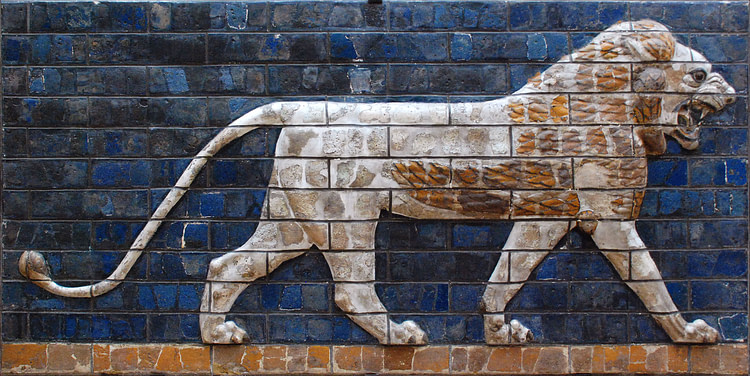
Babylon is the most famous city from ancient Mesopotamia whose ruins lie in modern-day Iraq 59 miles (94 kilometres) southwest of Baghdad. The name is thought to derive from bav-il or bav-ilim which, in the Akkadian language of the time, meant 'Gate of God' or `Gate of the Gods' and `Babylon' coming from Greek. The city owes its fame (or infamy) to the many references the Bible makes to it; all of which are unfavourable. In the Book of Genesis, chapter 11, Babylon is featured in the story of The Tower of Babel and the Hebrews claimed the city was named for the confusion which ensued after God caused the people to begin speaking in different languages so they would not be able to complete their great tower to the heavens (the Hebrew word bavel means `confusion').
Babylon also appears prominently in the biblical books of Daniel, Jeremiah, and Isaiah, among others, and, most notably, The Book of Revelation. It was these biblical references which sparked interest in Mesopotamian archaeology and the expedition by the German archaeologist Robert Koldewey who first excavated the ruins of Babylon in 1899 CE. Outside of the sinful reputation given it by the Bible, the city is known for its impressive walls and buildings, its reputation as a great seat of learning and culture, the formation of a code of law which pre-dates the Mosaic Law, and for the Hanging Gardens of Babylon which were man-made terraces of flora and fauna, watered by machinery, which were cited by Herodotus as one of the Seven Wonders of the World.
THE OLD CITY & HAMMURABI
Babylon was founded at some point prior to the reign of Sargon of Akkad (also known as Sargon the Great ) who ruled from 2334-2279 BCE and claimed to have built temples at Babylon (other ancient sources seem to indicate that Sargon himself founded the city). At that time, Babylon seems to have been a minor city or perhaps a large port town on the Euphrates River at the point where it runs closest to the river Tigris. Whatever early role the city played in the ancient world is lost to modern-day scholars because the water level in the region has risen steadily over the centuries and the ruins of Old Babylon have become inaccessible. The ruins which were excavated by Koldewey, and are visible today, date only to well over one thousand years after the city was founded. The historian Paul Kriwaczek, among other scholars, claims it was established by the Amorites following the collapse of the Third Dynasty of Ur. This information, and any other pertaining to Old Babylon, comes to us today through artifacts which were carried away from the city after the Persian invasion or those which were created elsewhere.
EVERY ANCIENT WRITER MENTIONS BABYLON WITH A TONE OF AWE AND REVERENCE.
The known history of Babylon, then, begins with its most famous king: Hammurabi (1792-1750 BCE). This obscure Amoriteprince ascended to the throne upon the abdication of his father, King Sin-Muballit, and fairly quickly transformed the city into one of the most powerful and influential in all of Mesopotamia. Hammurabi's law codes are well known but are only one example of the policies he implemented to maintain peace and encourage prosperity. He enlarged and heightened the walls of the city, engaged in great public works which included opulent temples and canals, and made diplomacy an integral part of his administration. So successful was he in both diplomacy and war that, by 1755 BCE, he had united all of Mesopotamia under the rule of Babylon which, at this time, was the largest city in the world, and named his realm Babylonia.
THE ASSYRIANS, CHALDEANS, & NEBUCHADNEZZAR II
Following Hammurabi's death, his empire fell apart and Babylonia dwindled in size and scope until Babylon was easily sacked by the Hittites in 1595 BCE. The Kassites followed the Hittites and re-named the city Karanduniash. The meaning of this name is not clear. The Assyrians then followed the Kassites in dominating the region and, under the reign of the Assyrian ruler Sennacherib (reigned 705-681 BCE), Babylon revolted. Sennacherib had the city sacked, razed, and the ruins scattered as a lesson to others. His extreme measures were considered impious by the people generally and Sennacherib's court specifically and he was soon after assassinated by his sons. His successor, Esarhaddon, re-built Babylon and returned it to its former glory. The city later rose in revolt against Ashurbanipal of Nineveh who besieged and defeated the city but did not damage it to any great extent and, in fact, personally purified Babylon of the evil spirits which were thought to have led to the trouble. The reputation of the city as a center of learning and culture was already well established by this time.
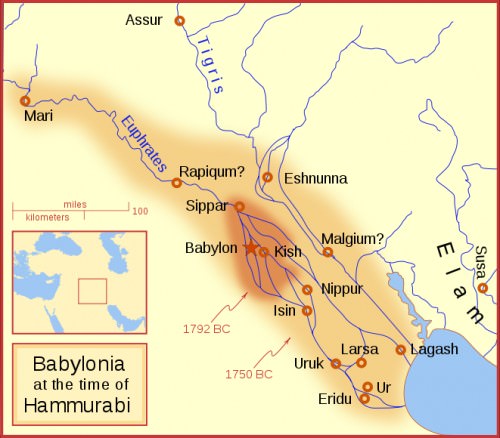
Babylon at the time of Hammurabi
After the fall of the Assyrian Empire, a Chaldean named Nabopolassar took the throne of Babylon and, through careful alliances, created the Neo-Babylonian Empire. His son, Nebuchadnezzar II (604-561 BCE), renovated the city so that it covered 900 hectares (2,200 acres) of land and boasted some the most beautiful and impressive structures in all of Mesopotamia. Every ancient writer to make mention of the city of Babylon, outside of those responsible for the stories in the Bible, does so with a tone of awe and reverence. Herodotus, for example, writes:
The city stands on a broad plain, and is an exact square, a hundred and twenty stadia in length each way, so that the entire circuit is four hundred and eighty stadia. While such is its size, in magnificence there is no other city that approaches to it. It is surrounded, in the first place, by a broad and deep moat, full of water, behind which rises a wall fifty royal cubits in width and two hundred in height.
Although it is generally believed that Herodotus greatly exaggerated the dimensions of the city (and may never have actually visited the place himself) his description echoes the admiration of other writers of the time who recorded the magnificence of Babylon, and especially the great walls, as a wonder of the world. It was under Nebuchadnezzar II's reign that the Hanging Gardens of Babylon are said to have been constructed and the famous Ishtar Gate built. The Hanging gardens are most explicitly described in a passage from Diodorus Siculus (90-30 BCE) in his work Bibliotheca Historica Book II.10:
There was also, because the acropolis, the Hanging Garden, as it is called, which was built, not by Semiramis, but by a later Syrian king to please one of his concubines; for she, they say, being a Persian by race and longing for the meadows of her mountains, asked the king to imitate, through the artifice of a planted garden, the distinctive landscape of Persia. The park extended four plethra on each side, and since the approach to the garden sloped like a hillside and the several parts of the structure rose from one another tier on tier, the appearance of the whole resembled that of a theatre. When the ascending terraces had been built, there had been constructed beneath them galleries which carried the entire weight of the planted garden and rose little by little one above the other along the approach; and the uppermost gallery, which was fifty cubits high, bore the highest surface of the park, which was made level with the circuit wall of the battlements of the city. Furthermore, the walls, which had been constructed at great expense, were twenty-two feet thick, while the passage-way between each two walls was ten feet wide. The roofs of the galleries were covered over with beams of stone sixteen feet long, inclusive of the overlap, and four feet wide. The roof above these beams had first a layer of reeds laid in great quantities of bitumen, over this two courses of baked brick bonded by cement, and as a third layer a covering of lead, to the end that the moisture from the soil might not penetrate beneath. On all this again earth had been piled to a depth sufficient for the roots of the largest trees; and the ground, which was levelled off, was thickly planted with trees of every kind that, by their great size or any other charm, could give pleasure to beholder. And since the galleries, each projecting beyond another, all received the light, they contained many royal lodgings of every description; and there was one gallery which contained openings leading from the topmost surface and machines for supplying the garden with water, the machines raising the water in great abundance from the river, although no one outside could see it being done. Now this park, as I have said, was a later construction.
This part of Diodorus' work concerns the semi-mythical queen Semiramis (most probably based on the actual Assyrian queen Sammu-Ramat who reigned 811-806 BCE). His reference to "a later Syrian king" follows Herodotus' tendency of referring to Mesopotamia as ` Assyria '. Recent scholarship on the subject argues that the Hanging Gardens were never located at Babylon but were instead the creation Sennacherib at his capital of Nineveh. The historian Christopher Scarre writes:
Sennacherib's palace [at Nineveh] had all the usual accoutrements of a major Assyrian residence: colossal guardian figures and impressively carved stone reliefs (over 2,000 sculptured slabs in 71 rooms). Its gardens, too, were exceptional. Recent research by British Assyriologist Stephanie Dalley has suggested that these were the famous Hanging Gardens, one of the Seven Wonders of the Ancient World. Later writers placed the Hanging Gardens at Babylon, but extensive research has failed to find any trace of them. Sennacherib's proud account of the palace gardens he created at Nineveh fits that of the Hanging Gardens in several significant details (231).
This period in which the Hanging Gardens were allegedly built was also the time of the Babylonian Exile of the Jews and the period in which the Babylonian Talmud was written. The Euphrates River divided the city in two between an `old' and a `new' city with the Temple of Marduk and the great towering ziggurat in the center. Streets and avenues were widened to better accommodate the yearly processional of the statue of the great god Marduk in the journey from his home temple in the city to the New Year Festival Temple outside the Ishtar Gate.
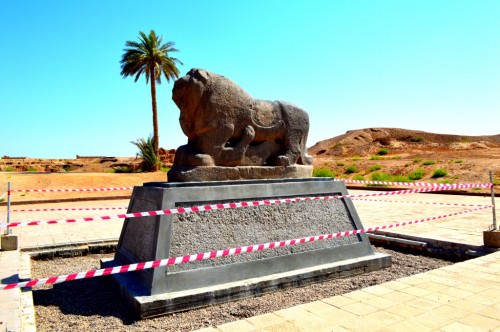
Lion of Babylon Statue, Babylonia
THE PERSIAN CONQUEST & BABYLON'S DECLINE
The Neo-Babylonian Empire continued after the death of Nebuchadnezzar II and Babylon continued to play an important role in the region under the rule of Nabonidus and his successor Belshazzar (featured in the biblical Book of Daniel). In 539 BCE the empire fell to the Persians under Cyrus the Great at the Battle of Opis. Babylon's walls were impregnable and so the Persians cleverly devised a plan whereby they diverted the course of the Euphrates River so that it fell to a manageable depth.While the residents of the city were distracted by one of their great religious feast days, the Persian army waded the river and marched under the walls of Babylon unnoticed. It was claimed the city was taken without a fight although documents of the time indicate that repairs had to be made to the walls and some sections of the city and so perhaps the action was not as effortless as the Persian account maintained.
Under Persian rule, Babylon flourished as a center of art and education. Cyrus and his successors held the city in great regard and made it the administrative capital of their empire (although at one point the Persian emperor Xerxes felt obliged to lay siege to the city after another revolt). Babylonian mathematics, cosmology, and astronomy were highly respected and it is thought that Thales of Miletus (known as the first western philosopher) may have studied there and that Pythagorasdeveloped his famous mathematical theorem based upon a Babylonian model. When, after two hundred years, the Persian Empire fell to Alexander the Great in 331 BCE, he also gave great reverence to the city, ordering his men not to damage the buildings nor molest the inhabitants. The historian Stephen Bertman writes, “Before his death, Alexander the Great ordered the superstructure of Babylon's ziggurat pulled down in order that it might be rebuilt with greater splendor. But he never lived to bring his project to completion. Over the centuries, its scattered bricks have been cannibalized by peasants to fulfill humbler dreams. All that is left of the fabled Tower of Babel is the bed of a swampy pond.”
After Alexander's death at Babylon, his successors (known as `The Diadochi', Greek for `successors') fought over his empire generally and the city specifically to the point where the residents fled for their safety (or, according to one ancient report, were re-located). By the time the Parthian Empire ruled the region in 141 BCE Babylon was deserted and forgotten. The city steadily fell into ruin and, even during a brief revival under the Sassanid Persians, never approached its former greatness. In the Muslim conquest of the land in 650 CE whatever remained of Babylon was swept away and, in time, was buried beneath the sands. In the 17th and 18th centuries CE European travelers began to explore the area and return home with various artifacts.These cuneiform blocks and statues led to an increased interest in the region and, by the 19th century CE, an interest in biblical archaeology drew men like Robert Koldewey who uncovered the ruins of the once great city of the Gate of the Gods.
MAP
Perdiccas › Who Was
Definition and Origins

Perdiccas (d. 321 BCE) was one of Alexander the Great 's commanders, and after his death, custodian of the treasury, regent over Philip III and Alexander IV, and commander of the royal army. When Alexander the Great crossed the Hellespont and threw his spear onto the shore of Asia Minor, he and his loyal army began a ten-year journey that would take them to the far reaches of Asia, amassing an empire unlike any that had existed before it. However, the young king's sudden death in 323 BCE left a vast kingdom leaderless and in disarray; there was neither an immediate heir nor appointed successor. Perdiccas stepped to the forefront to offer a solution. With the king's signet ring in his hand, he attempted to keep the empire intact.Unfortunately, others loyal to the king maintained a different opinion. In the end, the various commanders took possession of their small piece of the territorial pie, leaving Perdiccas with only a slim chance of rebuilding what had already been lost.
EARLY CAREER
Perdiccas stepped to the forefront to offer a solution. With the king's signet ring in his hand, he attempted to keep the empire intact.
Much of what history knows about Perdiccas is not flattering, clouded by the hostile account in Ptolemy's history of Alexander and his conquest of Persia. Ptolemy I and Perdiccas had been constantly at odds with one another since Babylon, a conflict that would eventually lead to Perdiccas' death. However, other than Ptolemy's history, most dependable versions maintain that he was about the same age as Alexander (possibly a little older) and was the son of Orontes, a Macedonian noble from the House of Orestes, a royal family that had once ruled a small independent kingdom in the Macedonian highlands but whose power had been stripped by Philip II, Alexander's father.
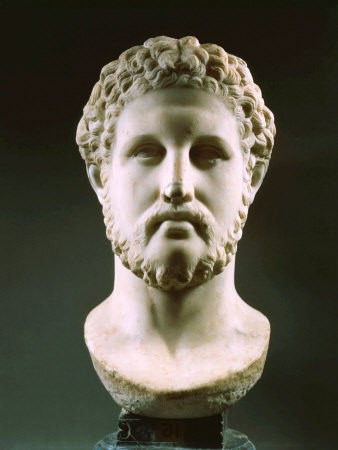
Philip II of Macedon
Initially, Perdiccas was a page in the imperial court at Pella, but in 336 BCE he became a member of Philip II's elite infantry, a shield-bearer or hypaspist. Later in the same year, serving as a king's bodyguard, Perdiccas was one of many who pursued Pausanias, Philip's murderer. The reason for the murder: Pausanias believed the king had betrayed him and sought revenge.When the assassin's boot caught on a vine as he hopped onto his horse, he was immediately slain by his pursuers. History still debates whether or not Olympias, Alexander's mother, had anything to do with the death of his husband. Many still believe she encouraged Pausanias to kill Philip to ensure Alexander's ascension to the throne. One of these was Plutarch who wrote in his The Life of Alexander the Great,
… when he found he could get no reparation for his disgrace at Philip's hands, watched his opportunity and murdered him. The guilt of which fact was laid for the most part upon Olympias, who was said to have encouraged and exasperated the enraged youth to revenge… (11)
REVOLT IN THEBES
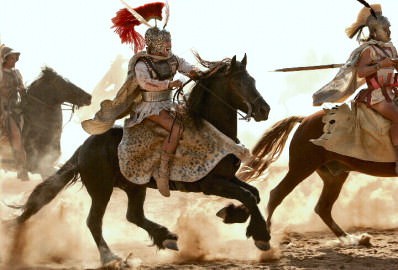
Alexander the Great in Combat
As "an eager young soldier who wanted to impress his king" (Freeman, 63), Perdiccas as captain of the guard was camped southeast of Thebes. Without consulting Alexander, he stormed the gates of the city and before anyone had realized it, was inside the walls, followed immediately by another battalion; the assault had begun, and with it "screams filled the air" (Freeman, 64). Although some accounts differ, Alexander had little alternative but to commit to the assault. Freeman wrote that the final result of the battle was one of "uncommon bravery mixed with butchery and horror" (64) as 6,000 Thebans would die while 30,000 were captured. The city itself was razed. The fall of Thebes had served its purpose as cities across Greece ceased to rebel. Perdiccas had proven himself to be a capable commander but at a price. In his The Campaigns of Alexander,the historian Arrian wrote that "Perdiccas was wounded while he was trying to break through the second palisade: he was carried back to the base, but the wound was serious and it was only with difficulty that his life was saved" (58).
PERSIAN CAMPAIGN & ALEXANDER'S DEATH
Perdiccas followed Alexander as he crossed into Asia Minor, fighting the Persians at Granicus, Issus, and Gaugamela.Throughout the Persian campaign, he received a number of promotions from a taxiarch leading a brigade of pezhetairoi to serving as a bodyguard in 330 BCE. Before the army was to meet King Porus at the River Hydaspes, Perdiccas and Hephaestion were sent ahead through the Khyber Pass with three battalions and half of the Companion Cavalry to gather supplies and prepare to bridge the river. Following the victory against King Porus, Perdiccas was next seen with Alexander in his clash against the Mallians, where the king received one of his more serious wounds, an arrow piercing his lung.Supposedly, Perdiccas was the one who removed the arrow.
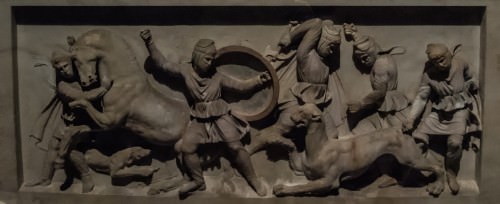
Alexander Sarcophogus
It was at Babylon as Alexander lay on his death bed that Perdiccas came into prominence. It was there that the king handed his signet ring to his newly appointed chiliarch Perdiccas; earlier he had received the promotion to chiliarch or Grand Vizier after the unexpected death of Hephaestion. Now, with the king dead (June 10, 323 BCE), the empire he had built fell into disarray. Sadly, Alexander had failed to provide a successor. History tells us that the final words of the king were "to the best," but no one understood what these words meant. Although his wife Roxanne was pregnant with the future Alexander IV, there was no one to rule the empire, so Perdiccas assumed control on his own initiative. He also took control of the king's body with the intention of returning it to a tomb in Macedon. Actually, despite the beliefs of his fellow commanders, many agree that Perdiccas was a good choice. By most accounts, he was of royal blood and had a distinguished military career. And, while there were many who disliked him, especially Ptolemy I, he personally believed he was quite capable of managing a crisis.
WARS OF SUCCESSION
The question of who should rule forced the commanders to come to an agreement. Perdiccas chose to support either Alexander's half-brother Philip Arrhidaeus (who was seen by most as a halfwit) or wait until the birth of Roxanne's baby; Philip would serve as Philip III until Alexander IV, born in August of 323 BCE, was old enough to rule. The meeting did not go smoothly. Although no one seriously favored Alexander's son Heracles by his mistress Barsine, Meleager, an infantry commander, led a short-lived revolt, favoring Philip III over Alexander IV - the unborn child was dismissed as being only half Macedonian. The revolt was silenced when Meleager was killed by Perdiccas in a sanctuary where he had sought refuge. To ensure her son's ascension to the throne, Roxanne, with Perdiccas' blessing, poisoned both Alexander's other wife Statira ( Darius ' daughter) and her sister Drypetis (Hephaestion's wife) and threw them down a well. Plutarch wrote:
Roxanne, who was now with child …. being jealous of Statira … killed her and her sister, and threw their bodies into a well, which they filled up with earth, not without the privity and assistance of Perdiccas, who in the time immediately following the king's death … exercised the chief authority. (72)

Diadochi Satraps 323 BCE
In the end, although the commanders tentatively accepted Perdiccas' plan, they opted to divide the kingdom among themselves. They met in the king's throne room at Babylon; Ptolemy I opted to rule Egypt, Antipater kept Macedon and Greece, while Antigonus I the One-Eyed received the majority of Asia Minor. Perdiccas received no territory or satrap, becoming instead custodian of the treasury, regent over Philip III and Alexander IV, and commander of the royal army. To spy on Ptolemy, Perdiccas chose Cleomenes of Naucratis to remain in Egypt as finance minister. Unfortunately, the plan of reuniting the empire would never come to fruition. The individual commanders and their descendants would clash for another three decades in the Wars of Succession.
AFTER ALEXANDER'S DEATH, PERDICCAS, WITH THE KING'S SIGNET RING IN HIS HAND, ATTEMPTED TO KEEP THE EMPIRE INTACT.
Marriage became a problem for Perdiccas, at least when he attempted to use it for political gain. During Alexander's attempt to marry his commanders to Persian wives, Perdiccas received the daughter of the governor of Medea. Later, (little is known of his Persian wife) he planned to marry Antipater's daughter Nicaea and form an advantageous alliance; it was also prearranged for Ptolemy to marry Antipater's daughter Eurydice. Meanwhile, the now-widowed Cleopatra, the sister of Alexander the Great, traveled to Asia Minor having set her eyes on Perdiccas. Antipater and Olympias both sought him as a possible son-in-law; Antipater wanted him to marry Nicaea while Olympias hoped he would marry Cleopatra. Perdiccas was caught in a dilemma; to marry Nicaea would align him with the other generals, but to wed the heir to Epirus and Macedon, Cleopatra, would lead him to a throne in Pella. In the end he married Nicaea; however, he sent Eumenes, who commanded his forces in Asia Minor, to Sardis in Asia Minor to inform Cleopatra that he was planning to reject Nicaea and marry her in a complete betrayal of Antipater. Unfortunately, when she discovered he had already married, Cleopatra rejected the offer.
This sense of betrayal combined with Perdiccas and Eumenes' advance into Asia Minor gave Antipater and his fellow regent Craterus little choice but to join Antigonus in a war (322 -321 BCE) to force Perdiccas out of power. Antigonus and his son Demetrius had initially sought refuge in Macedon when Eumenes entered Asia Minor. The war would end with the death of Craterus, isolation for Eumenes, and Antipater taking Philip III and Alexander IV to Macedon. The reigning queen Olympias was not happy with the outcome.
DEATH & LEGACY
Perdiccas had not participated in the war in Asia Minor; instead, in 321 BCE he was on his way to Egypt. Ptolemy I had kidnapped the body of Alexander in Syria and sent it to Memphis, later to be transferred to Alexandria. The two men had quarreled bitterly since Babylon, and with both Ptolemy's highjacking of the king's body and his murder of Cleomenes, Perdiccas believed he had little choice but to invade Egypt, defeat Ptolemy and seize both his territory and his treasury.However, in three futile attempts he failed to cross the Nile River. With the failure of his third and final attempt and a loss of 2,000 soldiers, the loyalty of his men began to falter as they had seen too many of their friends die. Desertions increased, bribes failed. In the end, three of his once loyal officers, Peithon, Antigenes, and Seleucus, entered his tent and stabbed him.
Perdiccas was a capable and loyal commander to both Alexander and the empire he had built. His one dream was to maintain the kingdom until it could be reunited under one leader, Alexander IV, the son of Alexander the Great. Unfortunately, he was not very popular with many of the old commanders, especially Ptolemy I of Egypt, and with the division of the territory at Babylon, the chance of any reunification died. In the end, Perdiccas lost control and his war with Ptolemy brought his death.The Wars of Succession would last another three decades, but Ptolemy's descendants would rule Egypt until the days of Julius Caesar. The king's beloved Macedon would fall into the hands of the Roman Empire. Alexander's dream of an empire had died with him.
MAP
LICENSE:
Article based on information obtained from these sources:with permission from the Website Ancient History Encyclopedia
Content is available under License Creative Commons: Attribution-NonCommercial-ShareAlike 3.0 Unported. CC-BY-NC-SA License